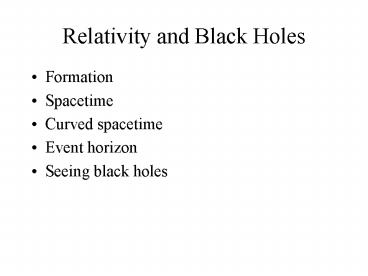Relativity and Black Holes - PowerPoint PPT Presentation
1 / 20
Title:
Relativity and Black Holes
Description:
Mass versus radius for a neutron star. Objects too heavy to be neutron ... If Alpha Centauri exploded 3 second ago, could there be any effect now on Earth? Yes ... – PowerPoint PPT presentation
Number of Views:44
Avg rating:3.0/5.0
Title: Relativity and Black Holes
1
Relativity and Black Holes
- Formation
- Spacetime
- Curved spacetime
- Event horizon
- Seeing black holes
2
A more massive neutron star has
- A smaller radius
- A larger radius
- Radius is independent of mass
- No radius
3
Mass versus radius for a neutron star
Objects too heavy to be neutron stars collapse to
black holes
4
Special Relativity
- Speed of light is constant
- Time dilation
- Simultaneity
- Length Contraction
- Spacetime diagrams
5
(No Transcript)
6
Speed of light is constant
7
Our conceptions of space and time has to be
changed.
- Facts
- Regardless of speed or direction, observers
always measure the speed of light to be the same
value. - Speed of light is maximum possible speed.
- Consequences
- The length of an object decreases as its speed
increases - Clocks passing by you run more slowly than do
clocks at rest
8
Time dilation
9
Time dilation
10
Simultaneity
Light in center of car flashes, hits front and
back simultaneously.
To an observer watching the car move, the car
travels while the light is in motion. So the
light hits the back of the car before the front.
11
Special Relativity Length Contraction
12
Special Relativity
Time dilation
Length contraction
Mass dilation
13
As an object speeds up, an observer at rest would
see
- It get longer and its clock run faster
- It get shorter and its clock run faster
- It get longer and its clock run slower
- It get shorter and its clock run slower
14
How long does it take to get to Vega?
Vega is 25 light years away, assume travel is at
0.999 c. Time for trip should be about 25 years.
But since clocks of moving object slow down, the
time elapsed on a clock taken on the trip is only
15
Spacetime Diagram
16
Spacetime Diagram
Geodesic shortest path between two
points. Particles follow geodesics in spacetime.
17
Spacetime Diagram
18
If Alpha Centauri exploded 3 second ago, could
there be any effect now on Earth?
- Yes
- No
19
Coordinate Transformation
20
Coordinate Transformation
In relativity, coordinate transformations can mix
space and time.

